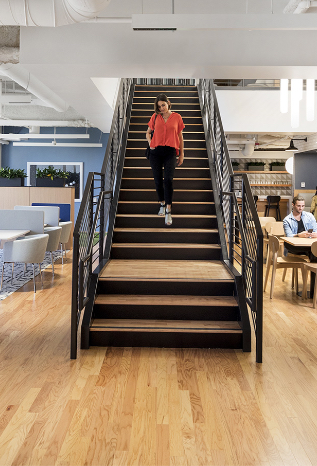As we touched on yesterday, the real design breakthrough occurred in Germany around the 1960’s and was termed Burolandschaft – Office Landscaping. A layout chart from the time shows a seemingly higgledy-piggledy arrangement of desks and staff, with desks arranged close together and pointing every which way creating individual work zones of different sizes.
 There was though, a certain method to the apparent madness. “The layout was based upon an intensive study of patterns of communication – between different parts of the organisation, different individuals,” says Duffy, who became a leading exponent of Burolandschaft.
There was though, a certain method to the apparent madness. “The layout was based upon an intensive study of patterns of communication – between different parts of the organisation, different individuals,” says Duffy, who became a leading exponent of Burolandschaft.
With previous Office designs communication or chatter was frowned upon as it was seen as counterproductive but the new layouts positively encouraged discussion, debate and conjecture amongst staff. Managers were working alongside their staff and costs were reduced as private manager’s offices were no longer needed and if someone did gain a promotion they wouldn’t have to be moved to a new or different office. Inevitably they didn’t even need to move desks, making any changes quicker and more efficient.
But as with a few other design headaches from the 1960’s, the practical application of this system didn’t only generate the co-working environment that everyone hoped. As many of us who have worked in this layout now realise, too much communication isn’t necessarily a good thing, shouting matches with teenage children over the phone, arguments with spouses, or the deconstruction of the previous night’s TV also being shared within the open plan office environment.
“Nobody can understand two people talking at the same time,” says Julian Treasure, chairman of the Sound Agency.
“Now that’s key when we’re talking about open-plan offices, because if I’m trying to do work, it requires me to listen to a voice in my head to organise symbols, to organise a flow of words and put them down on paper.”
If someone else is speaking your “auditory bandwidth” is full, he says, and it becomes very hard to listen to that voice in your head.
Alexi Marmot, an architect and lecturer at University College London, agrees that although loud background noise probably does affect workers’ ability to concentrate, and therefore their productivity, another key question for management is how agreeable the environment is for employees.
And in some open-plan offices, particularly the “classroom” type, there can be too little noise.
“In many open-plan offices, the argument is exactly the opposite – it’s deathly quiet,” she says. “A lot of open-plan offices are just rows of people only working at their computers. And people don’t want to be there.”
Consider the issues with heating levels in the Winter and air conditioning in the Summer, finding a radio station that everyone likes etc etc and some of the other issues associated with communal working start to become apparent. A 2009 review article published in the Asia-Pacific Journal of Health Management found that 90% of studies looking at open-plan offices linked them to health problems such as stress and high blood pressure. A separate study in Sweden in 2009 found that occupants of private offices were most happy with their environment, while most dissatisfaction was registered in medium and large open-plan offices.
Whatever the pros and cons it would appear that in the UK we are driven more by cost that consideration for staff as the vast majority of working environments are open plan. This differs greatly from some of our European neighbours, in Sweden almost everybody has a private office, while in Germany “open-office layouts are scarce” – although small teams sometimes shared a room. German office workers have an average 28.2 sq m of personal space with their right to elbow room and daylight enshrined in law.
How about your office, how or what layout do you use and are you affected by any of the issues raised in the article?
